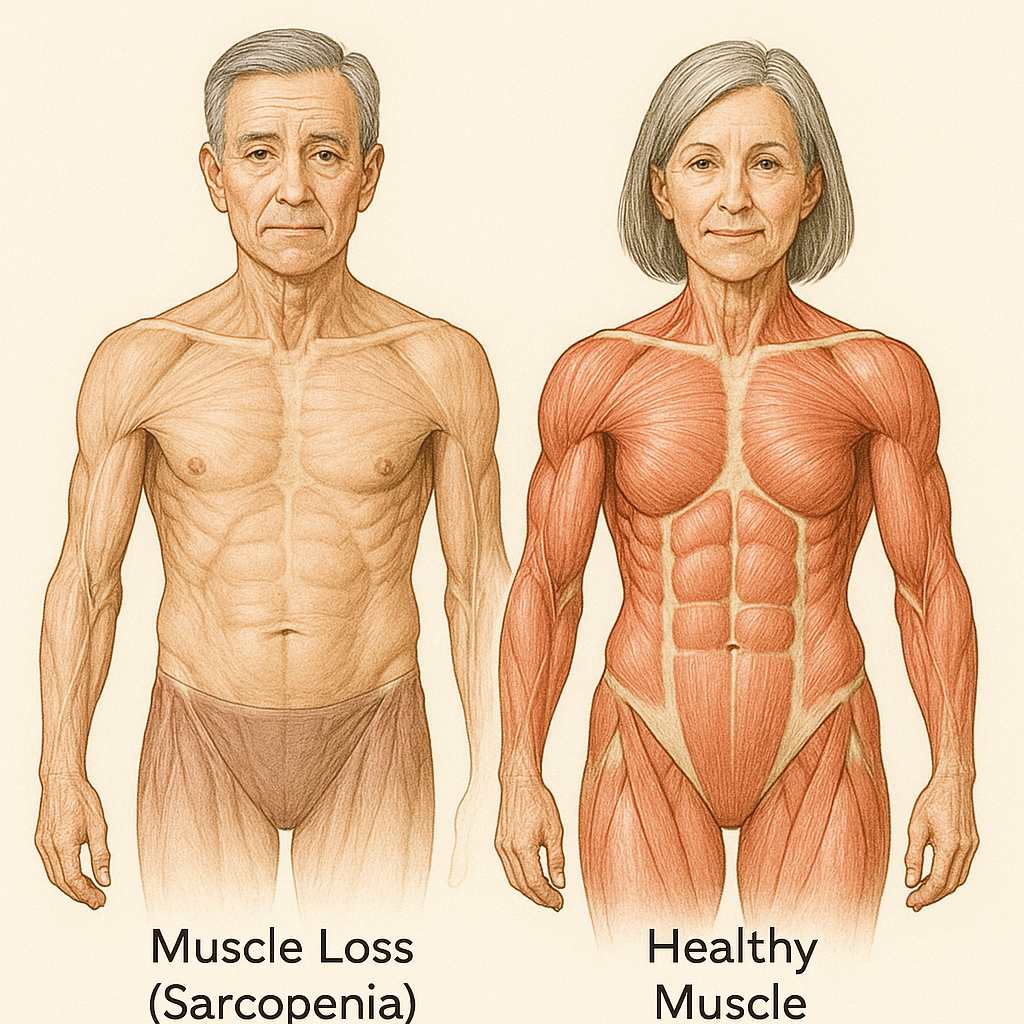You can absolutely build muscle at 50—science and professional trainers confirm it. In fact, building muscle after 50 is one of the most powerful things you can do to maintain your health, independence, and vitality as you age. Understanding why muscle loss happens, and knowing the specific, research-backed steps to reverse it, is key to feeling strong and confident at any age.
This guide walks you step-by-step through everything you need to know: the science of muscle loss after 50, essential strength-building strategies, nutrition and protein guidelines, the safest and most effective exercises, injury prevention, and a practical sample weekly plan. You’ll get answers to common questions and access to the latest expert advice, official recommendations, and authoritative resources to help you succeed.

For even more details, see the CDC’s “Growing Stronger” guide and The PROT-AGE Study on protein needs in older adults.
Why Muscle Loss Happens After 50 (and How to Reverse It)
As you reach your 50s and beyond, you may notice a decline in strength, muscle tone, and energy. This is primarily due to sarcopenia—the natural loss of muscle mass that occurs with aging. Studies show that adults can lose 1–2% of their muscle mass per year after age 50, especially if they are not regularly strength training.

Why does this happen?
- Hormonal Changes: Levels of growth hormone and testosterone decrease with age, slowing muscle protein synthesis.
- Reduced Physical Activity: Many adults become less active over time, further accelerating muscle loss.
- Inadequate Protein Intake: Older adults often eat less protein, despite needing more to support muscle repair and growth.
- Nervous System Changes: The ability of your nerves to stimulate muscle fibers weakens slightly, making it harder to maintain muscle strength.
The Good News: You can reverse or dramatically slow this process. The best tools? Consistent resistance training and increasing your daily protein intake.
Key Scientific Facts:
- Adults over 50 should consume at least 1.0–1.2 grams of protein per kg of body weight daily for optimal muscle maintenance and growth.
- Regular strength training is proven to increase muscle size and strength, even in people in their 70s and beyond.
Example: If you weigh 75 kg (165 lbs), aim for 75–90 grams of protein each day.
| Cause of Muscle Loss | Solution |
|---|---|
| Hormone decline | Resistance training, sleep |
| Less activity | Regular exercise |
| Low protein intake | Increase dietary protein |
Wikipedia: Sarcopenia
The Times: Fitness After 50
Strength Training Essentials for Over 50
Why Strength Training Is Non-Negotiable
Resistance training is the single most effective way to build muscle after 50. It counteracts sarcopenia, helps manage weight, improves bone density, and boosts your metabolism.
- Frequency: Aim for 2–3 full-body strength sessions each week.
- Exercise Selection: Focus on “compound” exercises that work multiple muscle groups at once.
- Progressive Overload: Gradually increase weights or resistance over time to challenge your muscles and stimulate growth.
Best Compound Exercises for Adults 50+
| Exercise | Target Areas | How To Do It Safely |
|---|---|---|
| Squats | Legs, glutes, core | Use bodyweight or light dumbbells; go to chair depth for safety |
| Deadlifts | Back, glutes | Start with a light kettlebell or dumbbell, keep your back flat |
| Push-Ups | Chest, arms | Use a bench or wall to make it easier if needed |
| Rows | Back, biceps | Use resistance bands or dumbbells |
| Planks | Core | Start with 10–20 seconds, increase gradually |
Trainer Tip: Always begin each workout with a 5–10 minute warm-up (walking, cycling, or dynamic stretching) and finish with gentle stretches to improve flexibility and reduce injury risk.
Science-Backed Sets and Reps
- 10–20 sets per muscle group per week is optimal for muscle growth.
- Start with 2–3 sets of 8–12 repetitions per exercise.
ZOE: Muscle Building & Aging
Marie Claire: Best Resistance Exercises
Science-Backed Workouts According to Trainers
How Top Trainers Structure Muscle-Building Workouts for Over-50 Adults
- Consistency matters more than intensity. Building muscle after 50 is about regular effort, not maximum effort.
- Proper form is critical. Good technique reduces injury risk and ensures you target the right muscles.
- Listen to your body. Never work through sharp pain, and adjust exercises as needed.
Sample Weekly Workout Plan
| Day | Focus | Example Exercises |
|---|---|---|
| Monday | Upper Body | Push-Ups, Dumbbell Rows, Planks |
| Wednesday | Lower Body | Squats, Lunges, Glute Bridges |
| Friday | Full Body | Deadlifts, Shoulder Press, Bird Dogs |
- Rest 48 hours between working the same muscle group.
- Rest 60–90 seconds between sets.
- Start light—focus on perfecting your form before adding weight.
Nutrition & Protein Strategy After 50
Why Nutrition Is Just as Important as Exercise
Building muscle isn’t possible without the right nutrients, especially protein. Aging bodies use protein less efficiently, so getting enough protein is essential.
- Protein: Consume 1.0–1.2 grams per kilogram of body weight daily.
- Timing: Distribute protein evenly throughout your meals (breakfast, lunch, dinner, snack).
- Whole Foods First: Prioritize lean meats, eggs, dairy, beans, and tofu. Use protein shakes to fill gaps.
| Protein Food | Grams Protein per Serving |
|---|---|
| Chicken breast (3 oz) | 27 |
| Greek yogurt (1 cup) | 20 |
| Eggs (2) | 12 |
| Lentils (1 cup) | 18 |
| Protein shake | 20–25 |
Supplement Support
- Leucine and HMB can support muscle synthesis, especially for those with low protein intake or on plant-based diets.
- Vitamin D and omega-3s may help with muscle and joint health.
If you struggle to get enough protein from food, add a daily protein shake.
PROT-AGE Study: Protein in Older Adults
Recovery, Rest & Injury Prevention
Why Recovery Is Critical After 50
Muscles are built outside the gym, during rest and sleep. As you age, you need more time to recover—don’t rush it!
Rest & Recovery Tips
- Get 7–9 hours of sleep nightly for best results.
- Take at least one full rest day between strength sessions.
- Do mobility or gentle stretching on off days to maintain flexibility.
- Listen to pain: Sharp or persistent pain is a warning sign. If you experience it, stop and consult a professional.
Injury Prevention Strategies
- Warm up: 5–10 minutes of light movement before every workout.
- Cool down: End with static stretching.
- Hydrate and fuel: Drink water and eat a balanced meal within 1–2 hours of training.
Example: Many over-50 athletes do best with a “train-rest-train-rest” rhythm, such as Monday-Thursday strength days and light activities on other days.
Sample Weekly Plan for Beginners at 50+
If you’re new to strength training or returning after a break, start here:
| Day | Workout |
|---|---|
| Monday | Full-Body Strength (Squat, Row, Push-Up) |
| Tuesday | Rest or Brisk Walking |
| Wednesday | Lower Body + Core (Lunges, Glute Bridge, Plank) |
| Thursday | Rest or Yoga/Mobility |
| Friday | Upper Body (Chest Press, Shoulder Press, Biceps Curl) |
| Saturday | Optional HIIT (15–20 min, low impact) or Walk |
| Sunday | Rest |
- Use light weights or just bodyweight at first.
- Track your workouts and aim for gradual progress—add reps, weight, or sets as you improve.
- Pair strength training with gentle cardio (walking, cycling, swimming) for heart health.
Supplements & Extras – Kettlebells, HIIT, and Vitamin D
Kettlebells
Kettlebells are excellent for improving strength, coordination, and balance, especially in older adults. Start with light weights (5–10 lbs), learn proper technique, and focus on controlled movements.
HIIT (High-Intensity Interval Training)
HIIT workouts can improve cardiovascular health and help maintain muscle, but should be approached cautiously if you’re new to exercise or have joint issues. Choose low-impact moves and keep sessions short (15–20 minutes).
Vitamin D
Vitamin D is important for muscle and bone health. If you don’t get much sun or your doctor recommends it, a vitamin D supplement may help support muscle strength.
Verywell Health: Kettlebell Workouts for Older Adults
Stanford: Strength Training After 50
Frequently Asked Questions
Can I still build muscle at 60 or 70?
Yes! Research shows that people in their 60s, 70s, and beyond can gain strength and muscle through regular resistance training and a higher-protein diet.
Do I need a gym membership?
No. You can build muscle at home with resistance bands, dumbbells, or even your own body weight.
What if I have joint pain or injuries?
Modify exercises as needed (e.g., do squats to a chair, try wall push-ups). Always consult your doctor before starting a new program, especially if you have a health condition.
Conclusion
Building muscle at 50 is achievable and incredibly beneficial—science and top trainers agree! By following a consistent strength training program, eating enough protein, prioritizing rest, and paying attention to injury prevention, you can build and maintain strong, healthy muscles for life.
Authoritative External Links
- CDC: Growing Stronger for Older Adults
- PROT-AGE Study: Protein Intake in Older Adults
- Verywell Health: Kettlebell Workouts for Older Adults
